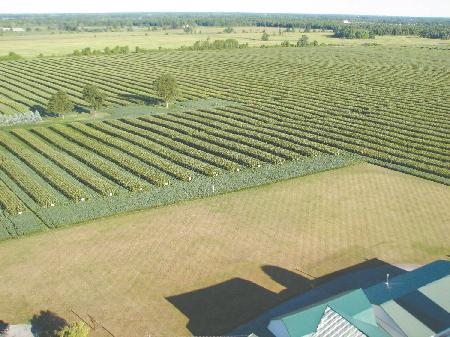 "When I was about 14 years old I remember we took out a fence and the soil in the fence row was very fertile and loose, with a defined soil structure. The first year, the corn in that strip of soil grew 2 ft. taller than in the rest of the field. However, over time the difference faded away," says Dean Glenney, Dunnville, Ontario, who has worked through the years to devise a tillage and planting system that would re-create that fence row-type of soil.
"When I was about 14 years old I remember we took out a fence and the soil in the fence row was very fertile and loose, with a defined soil structure. The first year, the corn in that strip of soil grew 2 ft. taller than in the rest of the field. However, over time the difference faded away," says Dean Glenney, Dunnville, Ontario, who has worked through the years to devise a tillage and planting system that would re-create that fence row-type of soil.
His first step was switching to an alternating pattern of planting corn and beans in the mid 1990's. He added a splitter to a new White planter with 6 planter boxes each. He offset the planter frame 4 in. to the left and the splitter 4 in. to the right. This produced twin-rows 8 in. apart. He added coulters to lay down dry fertilizer between the rows and 28 percent liquid to each side of the rows.
Each crop is rotated and planted directly over the rows of the previous year's crop. Doing so allows him to limit equipment traffic to 2 wheel tracks in each strip with tracks repeated every year. It's a process that is much easier with the development of GPS guidance systems, notes Glenney.
"Initially I had to leave a row of corn to eyeball the field to keep it straight," he says. "Now with GPS guidance, anybody can do it."
Wheels only touch his corn strips at planting and harvest. Soybean tracks also carry sprayer traffic; however even then, compaction is limited. The planter tractor is equipped with duals, spreading the weight over the entire 22-in. row space. The sprayer is set up so its wheels are on the inside of the space and the combine runs on the outside.
In order to limit the sprayer to the soybean strips, Glenney added extended wings and drop nozzles to cover 12 rows. When spraying corn, he activates 3 nozzles to the far left and right.
Getting his planting system in place was more difficult. For the first 10 years, heavy corn residue and corn root balls were a problem when planting soybeans. Glenney stumbled on a solution when he mounted a new opener coulter next to a worn one.
"It created a leading edge coulter that helped slice through the root ball," he explains. "That extra 1/4 in. changed planting. I put new coulters on half the openers, and it was amazing what it did."
Planter modifications continue as this year he replaced half his press wheels with sharp- tooth trash whippers.
"I put the trash whippers on at an angle and ran them backward," he says. "They push the soil in to fill the seed trench, and the remaining plain closing wheel presses it down."
The novel system has worked out well. His soil has responded, and yields have as well. He fertilizes the same as he did 20 years ago when his yield goal was 150 bu. per acre. However, in recent years he has won province-wide yield contests and hit yields of 300 bu. per acre in corn and a high yield of 72 bu. per acre in soybeans.
"I expected to sacrifice soybean yields with the strips, but yields of 60 to 70 bu. per acre aren't too shabby," says Glenney. "I figure shading from the corn is minimal, as I plant my rows east to west."
1-800-834-9665
Corn/Bean System Cuts Compaction, Builds Yield
FARM SHOW Magazine » Corn/Bean System Cuts Compaction, Builds Yield
Corn/Bean System Cuts Compaction, Builds Yield
